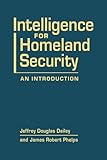Intelligence for Homeland Security : An Introduction / James Robert Phelps, Jeffrey Douglas Dailey.
Material type: TextPublisher: Boulder : Lynne Rienner Publishers, [2022]Copyright date: ©2021Description: 1 online resource (275 p.)Content type:
TextPublisher: Boulder : Lynne Rienner Publishers, [2022]Copyright date: ©2021Description: 1 online resource (275 p.)Content type: - 9781626379633
- 9781685851026
- 327.1273 23/eng/20230216
- online - DeGruyter
| Item type | Current library | Call number | URL | Status | Notes | Barcode | |
|---|---|---|---|---|---|---|---|
 eBook
eBook
|
Biblioteca "Angelicum" Pont. Univ. S.Tommaso d'Aquino Nuvola online | online - DeGruyter (Browse shelf(Opens below)) | Online access | Not for loan (Accesso limitato) | Accesso per gli utenti autorizzati / Access for authorized users | (dgr)9781685851026 |
Frontmatter -- Contents -- List of Tables and Figures -- Acknowledgments -- 1 Protecting the Homeland -- 2 The Origins of the Homeland Security Enterprise -- 3 The Creation of the Department of Homeland Security -- 4 The Role of the Intelligence Community -- 5 The Role of Homeland Security Agencies -- 6 The Role of Other Security Agencies -- 7 Counterintelligence Missions -- 8 Domestic Threats and National Security -- 9 Homeland vs. National vs. Practical Intelligence -- 10 Making the System Work -- 11 The Future of Intelligence in Homeland Security -- List of Acronyms -- Bibliography -- Index -- About the Book
restricted access online access with authorization star
http://purl.org/coar/access_right/c_16ec
Since the September 11 terrorist attacks—considered one of the worst intelligence failures in US history—the many agencies that constitute the homeland security enterprise have aggressively developed their intelligence capabilities and activities. Jeffrey Dailey and James Phelps provide a comprehensive introduction to the nature of intelligence, its structures, roles, and missions, in the context of homeland security. This accessible text: • Covers the full gamut of agencies involved in homeland security • Tackles difficult ethical issues • Discusses specific threats—ranging from drug trafficking and money laundering to bioterrorism and the challenges of Covid-19—and how they are dealt with by the intelligence community • Looks at how intelligence for national security can be applied to domestic security • Addresses the realities of intelligence sharing among federal, state, and local organizations. Enriched with numerous case studies of both successes and failures, the book has been carefully designed to meet the needs of students focusing on homeland security, intelligence, criminal justice, policing, security management, and related fields.
Mode of access: Internet via World Wide Web.
In English.
Description based on online resource; title from PDF title page (publisher's Web site, viewed 02. Mai 2023)


